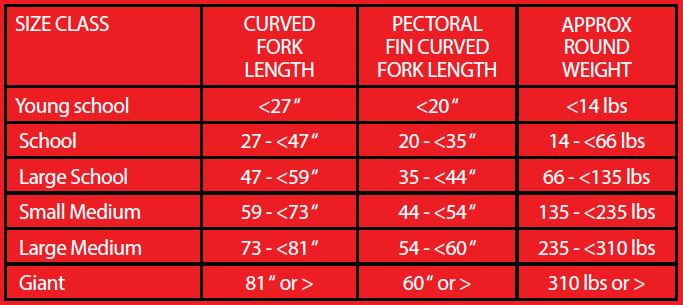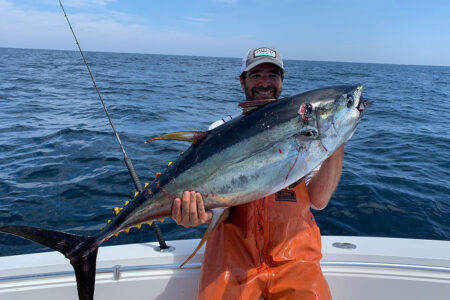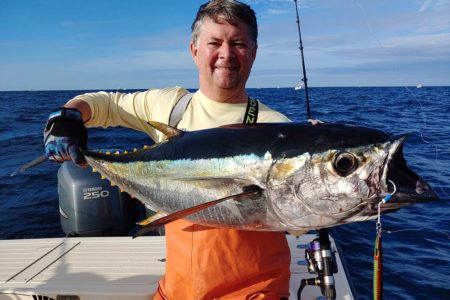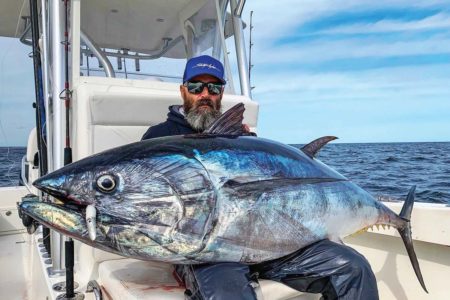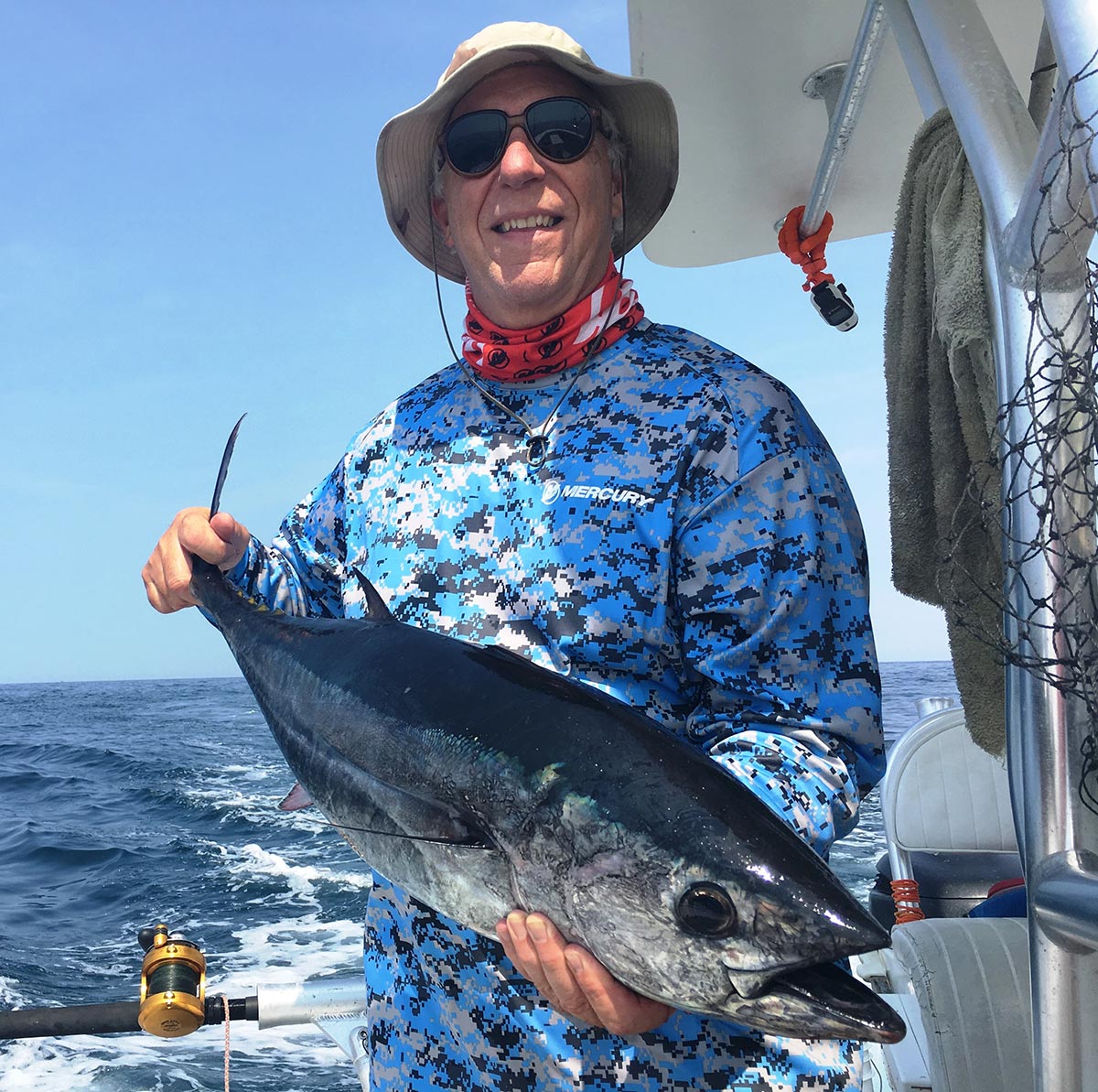
Here’s an in-depth look at what you need to do to get a piece of this fast and furious fishery.
The time for bluefin is now. The king of the thunnus tribe has already made an early appearance this year in mid-May in the DelMarVa, New Jersey and Long Island coastal areas, so the game is on. Bluefin in the initial months of the new season are typically migrating north from their wintering grounds in the Gulf of Mexico and the Carolinas to wherever it is along the mid-Atlantic and New England coastal areas they will eventually call their home hunting grounds for the summer and fall. After fattening up during the warm months, an age-old alarm goes off in their heads and it’s time to either reverse course, or jump across the pond and head towards the Mediterranean Sea. I have run into bluefin chasing mackerel schools in mid-March in 15-fathom waters and have seen them crash migrating pods of schoolie bass along the beach in early December in 5 fathoms of water. The blackfish crowd frequently reports spotting large school bluefin near the 15- to 20-fathom wrecks in late November and December. It seems that bluefin can be everywhere at one time and a few days later are nowhere to be found. They are aggressive swimmers and can cover 50-plus miles in a day, depending how incentivized they are to find food. If there is forage in your area, they might stay. If the bait is scarce, so are the bluefin. This species of tuna is unique from its siblings, in that bluefin have an internal heat exchanger mechanism that can warm their blood if required and can tolerate a wider spread of temperatures, especially on the colder side. They also have minimal fear of venturing into shallow coastal waters to pursue forage, and surfcasters occasionally tangle with these powerful tuna.
Even this year, there were bluefin reportedly mixed in with the mackerel schools off of Jersey and south of Long Island in late March and as of June 1, big numbers of bluefin seem to be everywhere along the south shore of Long Island, crashing bunker schools in 30 feet of water, spooling striper anglers with bunker snagging outfits; with schoolies spotted patrolling the 15- to 20-fathom areas; and larger fish hitting the usual 30-fathom spots a month early. New England anglers should also expect an early arrival of these fish as they work their way north. Each year is different, so be ready to run and gun on a moment’s notice at the first rumor that the BFTs are in your neighborhood.
The split migration model has been proven time and again by fisheries scientists over recent years using pop-up tags, and the Atlantic bluefin population is now thought of as being one large, somewhat homogeneous stock, with different east/west migration patterns, depending on the size and the age of the fish. I have confirmed this theory myself via tags that I have employed when releasing small school bluefin fishing south of Long Island. One such fish, an estimated 30-pound school tuna that I tagged in the late 1990s, was recovered six years later near Gibraltar at the mouth of the Mediterranean Sea by a Spanish longlining vessel. In the six years from its release, which occurred in late July approximately 15 NM south of Moriches Inlet, the fish had grown to a final capture weight of 285 pounds and at some point had “crossed the pond” to end up in the eastern Atlantic bluefin stock. This bluefin had packed on 255 pounds of mass in only six years, which equates to an average of 42.5 pounds per year. Eating good in the neighborhood!
Proven Techniques
Trolling, jigging, casting popping plugs and swimmers, and bait fishing are all proven techniques for taking early run bluefin. Here’s a quick summary of each:
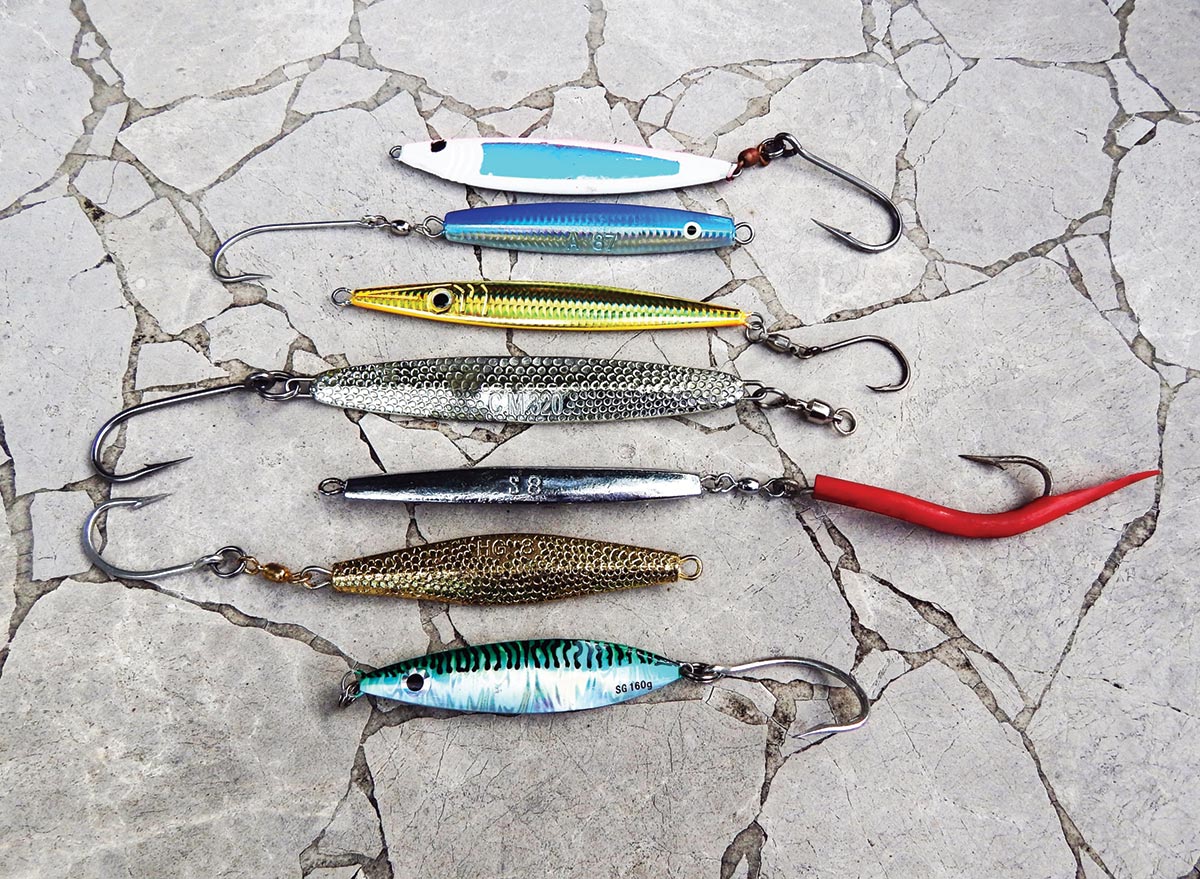
Trolling: As the name implies, this method requires that you drag an assortment of baits, lures and spreader bars in your wake at speeds ranging from 5 to 7.5 knots, which will be governed by sea conditions and the makeup of what’s in your spread. Best natural baits include naked ballyhoo and those adorned with a weighted skirt like an Ilander, Joe Schute, Sea Witch, etc. Local half-beaks (sauries) and squid will also produce, but usually require a slower trolling speed to avoid tearing them apart. Squid and Green Machine spreader bars, dredge bars and daisy chains are some of the top artificials to troll aft of your transom. Individual lures like Tuna Clones, Green Machines, jet heads, Psychobeads, Kona heads, Jap feathers, cedar jigs, etc. all have their place and moments in time. The typical tuna trolling spread for my 23-foot center console MarCeeJay includes a pair of jet heads in the second wave hooked to Aftco release clips on the transom, twin squid/Green Machine spreader bars coming directly off of the rod tips in the third wave, a pair of rigged ballyhoo/Joe Schute combos on small black birds (looks like a Stormy Petrel) attached to Reliable Rod Riggers in the 5th/6th wave. My shotgun rod is set 125 yards aft in my T-top’s rocket launcher to clear the spread that features an over-sized black/white Jap Bird that is trailing a rainbow colored Psychobead. Believe it or not, this one lure catches 90 percent of the bluefin for me and has done so for decades using different boats. Of course, your spread will vary based on the size of your boat, outrigger and center rigger setup, crew size, etc. Look for the signs—temp breaks, whales, bait sprays, meatballs on your sounder’s screen, porpoises, wrecks near fathom curves, fish greyhounding on the surface, etc. and get your baits/lures in the water.
Jigging: This has been one of the most popular methods of attacking pods of bluefin over the past decade and the run and gun action following this path can be totally too fast and too furious! When sand eels come into the area in swarms, the bluefin tend to hang out near the bottom, root their noses in the sand and then chow down on the tens of millions of sand eels that can often be in a school. You can forget about trolling and casting when this is the dominant food source in the area, since the majority of the action will be down deep. Look for breaching whales, porpoises and birds as a sign that you might be in the zone and confirm this by analyzing the images on your echo sounder. If you observe clouds of bait on the bottom, surrounded by inverted red and orange Vs, you are in the right place. Snap jigging, slow pitch jigging, yo-yo and modified squidding techniques will all work for this fishery and there are enough videos on the Fisherman’s website and YouTube that will show you the step-by-steps.
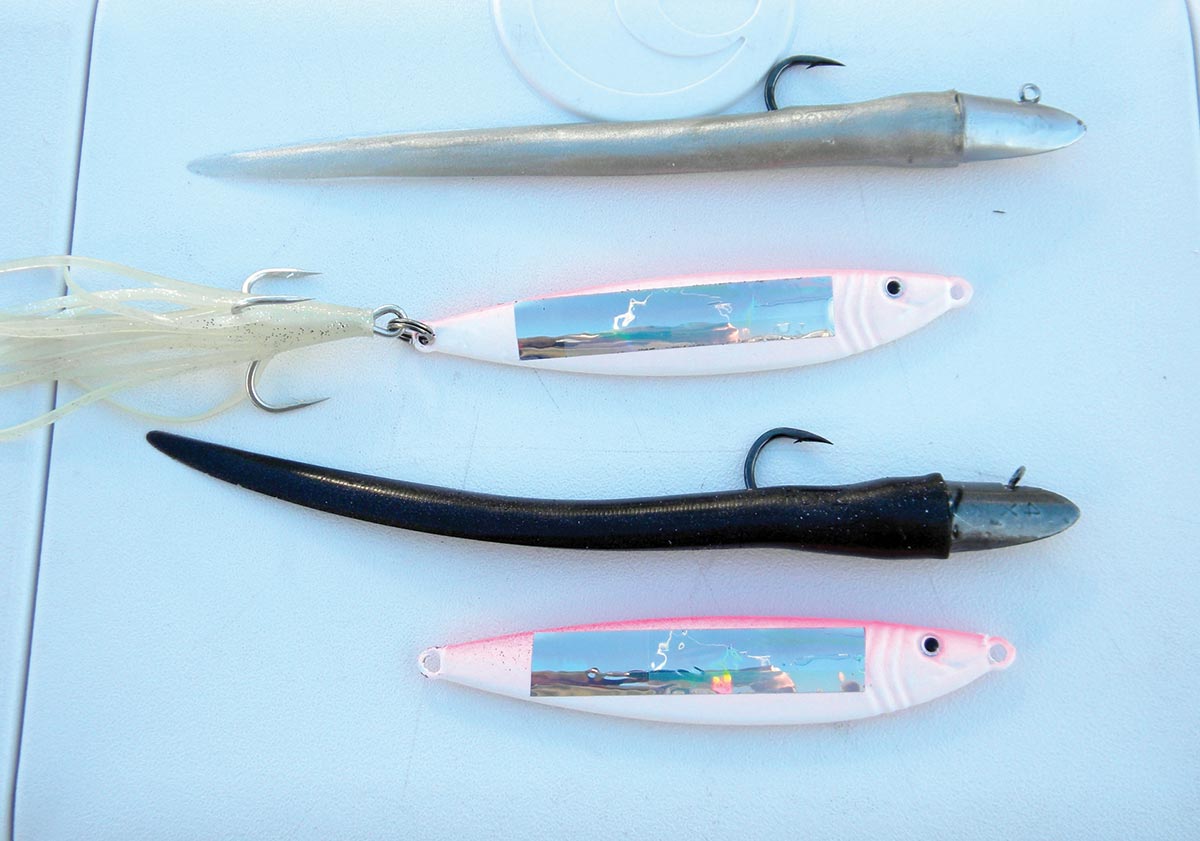
Surface Casting: There’s nothing as rewarding or entertaining in the tuna fishing game as casting a popper or swimming plug into a pod of surface feeding bluefin that are on the move and getting a wicked arm-wrenching strike and explosion that can only be described as “a refrigerator falling out of the sky.” A split second later, line will peel off your reel as if you had tied it to the back of someone’s pickup truck in the marina parking lot. This is where a 300- to 400-yard superbraid line capacity on your spinning or casting outfit is a requirement. Depending on the size of your thunnus, you may have to pick it up and run it down, or risk the possibility of getting spooled in 30 seconds or less. Assuming that you survive the initial strike and are still hooked up after some early inning blistering surface runs, the next phase is usually a trip down to the bottom, where that firm backbone in your rod makes all the difference when trying to hump up a bluefin from the lower depths. A gimbal belt and rod harness are indispensable items when practicing this version of mixed martial arts.
Chunking: This technique is the “old reliable” method when the fish are scattered over a specific area and are not responding to the first three methods described above. You can practice this art by drifting along with the wind and currents, or you can anchor up and chum/chunk with butterfish, baby bunker, sardines, mackerel, sand eels or whatever. I usually avoid using bunker chum here, so I don’t attract pesky sharks into the spread. Tying a 6- to 7-foot length of 40- to 50-pound fluorocarbon to a 4/0 to 6/0 4x live bait hook with a ball bearing swivel on the opposite end is a starting point for the typical bait rig. Bury the hook in your bait of choice to minimize its visible profile to the sharp-eyed tuna, send it out with the chunks to disguise its true purpose and hope that they find your free buffet. You may need to use a split shot, sliding egg sinker or a breakaway 2- to 8-ounce sinker to keep your baits in the spread, depending on sea conditions and current flow. You can suspend your hooked baits at different positions in the steady stream of chunks with small foam floats or balloons, but it’s also a good idea to free line at least one hooked bait with the chunk flow, allowing it to drift back at least 100 yards before you bring it in and start all over again. Depending on what type of hooks you choose to deploy (J-hooks vs circle), the hook setting technique will vary.
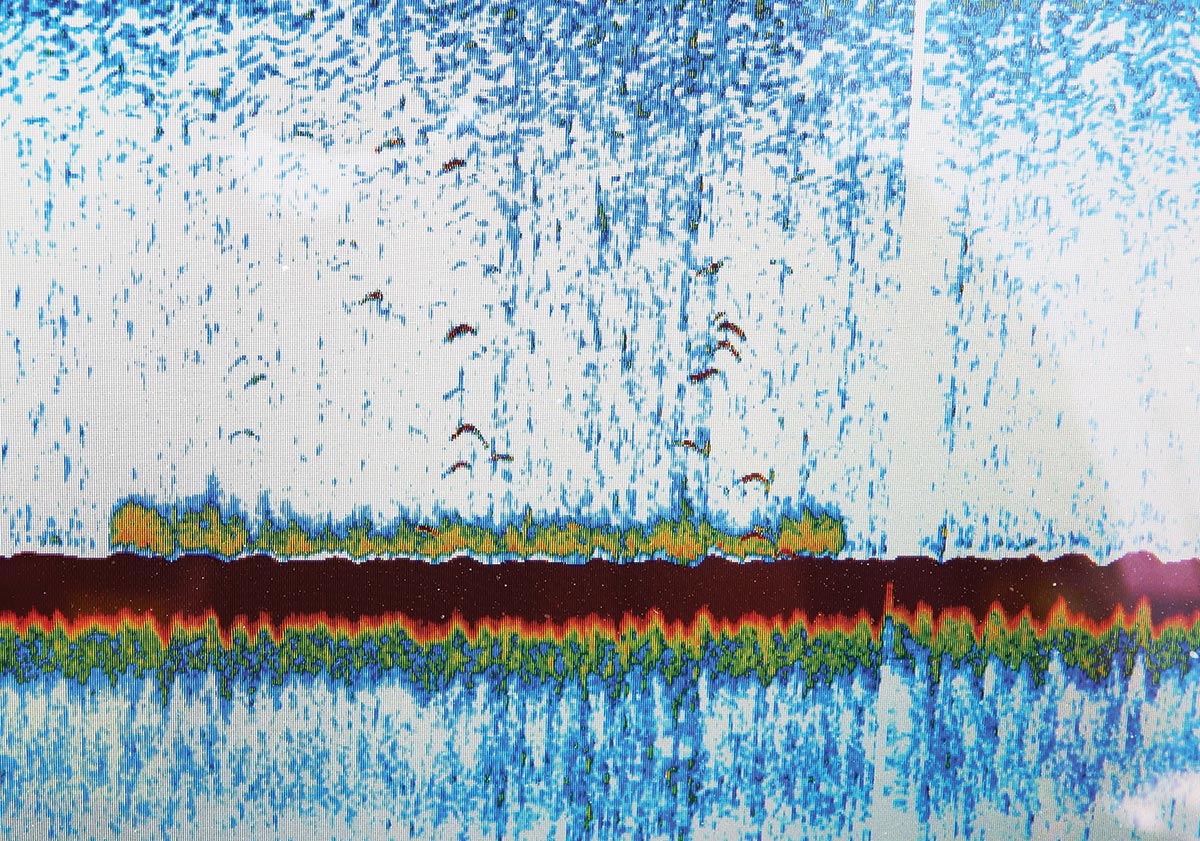
Tackle for the Task
Whatever tackle you prefer, whether it’s spinning, conventional or trolling, the rods should be stout with a good amount of backbone, and the reels need to have a smooth, powerful drag system with a generous line capacity. Superbraid is usually the line of choice for experienced tuna tanglers and a minimum 25- to 50-yard topshot of fluorocarbon or camo leader material is recommended. If you are using popping plugs, swimmers or sand eel jigs, 4x hooks and through-wire construction are highly recommended.
Everyone has their favorites and if you are jigging bluefin in a vertical format in deep water, a lightweight, two-speed reel like the Avet Raptor, Okuma Metaloid, Penn 12/16VSX, Shimano Talica 16 and others will give you a competitive chance to defeat your quarry. Finely tuned single speed reels like the Maxel Ocean Max and Rage models, Accurate Boss, Jigging Master and others of that high-end ilk will also hold their own in the run and gun tuna rodeo. Spool these up with 40- to 50-pound superbraid and a mono/fluoro top shot and you are in business. Any variety of sand eel imitation, blade or hammered silver/gold diamond jigs will work here. Locate the pods of sand eels and feeding bluefin on your sounder (typically at or near the bottom) and go to work employing either a yo-yo, slow pitch and/or modified squidding technique and be sure to hold onto your tackle when that hit finally comes and you come “tight.” It’s usually at this moment that the bluefin will show you second and third gears, as it takes you for a ride. Hopefully your tackle, knots and your stamina are up to the fight. These jigging outfits are also perfect to double down for chunking duties and their relatively light weight will not fatigue you over the course of a long day.
I use a variety of jigging rods for this fishery, including Maxel Ocean Max Gold, Tsunami Air and Penn Rampage sticks. All have their time and purpose and the majority are in the 5.5- to 6.5-foot range. These give you maximum handling, clearance from obstacles like T-tops, hardtops, rails and radio antennas, yet offer a good amount of leverage to coax a tough bluefin up from the depths.
If I am trolling inshore bluefin, I typically defer to my proven collection of Penn USA 16/20/30 VSX reels matched up to Penn International V one-piece trolling rods. Most of these are in 5.5- to 6-foot lengths for easy handling, sufficient clearance around outboards and motor wells, plus maximum leverage to hump a big thunnus to boatside. When it’s time to employ a popper or swimming plug to a school of surface feeding bluefin, I defer to a spinning outfit and have had good success with 5000-series Okuma Azores and Penn Battle reels spooled with a minimum of 300 yards of 40-pound superbraid, with a 10- to 15-yard fluoro topshot.
Watch Out for Whales
NOAA Fisheries reminds all fishermen and boaters to keep a safe distance from whales. Whales can get hooked in tuna rigs or tangled in monofilament line. They recommend boaters keep a distance of at least 100 feet from all whales (and at least 500 yards from endangered North Atlantic right whales, as required by federal law). In recent years, we have received increasing numbers of reports of tuna fishermen trolling their gear too close to humpback whales. This can result in injuries to both the whales and the people. Humpbacks create bubble clouds to corral their prey, and then lunge through the center to swallow the small fish. Fishermen or boaters in these bubble patches run the risk of colliding with a massive 79,000-pound humpback whale as it rapidly approaches the surface. When a whale collides with a vessel, it can be gravely injured and die from its injuries. Collisions with whales have also thrown boaters from vessels, causing injuries and even death.
| SIZE CLASS CATEGORIES OF ATLANTIC BLUEFIN TUNA |
|---|
|
Bluefin tuna are broken into six homogeneous size classes for regulatory purposes and these are as follows:
|
Permits and Reporting
Any recreational angler fishing for bluefin tuna falls under the HMS (highly migratory species) category jurisdiction, and the boat that they fish on to pursue Atlantic tunas, sharks, swordfish and billfish must have a permit that is good only for that boat and captain and their crew and is not transferable. Currently, permits are available at https://hmspermits.noaa.gov/permitlist.
The permit fee will vary between $26 and $52, depending on the permit you apply for, and is payable by credit card (Visa, Master Card, Discover, or American Express) or check/money order. You will need your Atlantic tunas or your Atlantic HMS permit number to renew your permit for the 2019 season. If you have any questions regarding the permit process, NOAA’s customer service representatives are available at (888) 872-8862, Monday through Friday, from 8 a.m. to 5 p.m. Eastern Time.
The tuna season is already in full swing. Be sure to have your permit onboard, and stick to the size and bag limits to avoid costly fines. Remember, all bluefin tuna landings and dead discards must be reported to NOAA Fisheries within 24 hours of the vessel returning from the trip. You can do this at https://hmspermits.noaa.gov/catchreports.
| SIZE & BAG LIMITS |
|---|
|
One fish per boat, two fish per boat, different slot sizes, one of each slot size, two and one, etc. The size and bag limits for recreational and Charter/Headboat caught bluefin can change once or twice within the same season, and is typically different from season to season. As of this writing (June 1, 2019), the current recreational bluefin size and bag limits are as follows (from https://hmspermits.noaa.gov/news) Effective May 11 through December 31, 2019, the BFT daily retention limits are the following:
These limits (which are per vessel per day/trip) are effective for all areas except the Gulf of Mexico. Regardless of the duration of a fishing trip (e.g., whether a vessel takes a two-day trip or makes two trips in one day), no more than a single day’s retention limit may be possessed, retained, or landed. Angling and Charter/Headboat vessels may also land one bluefin tuna measuring 73″ or greater per vessel per year north of 39°18’N (off Great Egg Inlet, NJ), as well as in the Gulf of Mexico (NOTE THAT GULF OF MEXCICO TROPHY BFT FISHERY CLOSED FRIDAY, MAY 31, 2019, at 11:30 pm). The trophy bluefin fishery for the southern area is closed. |
